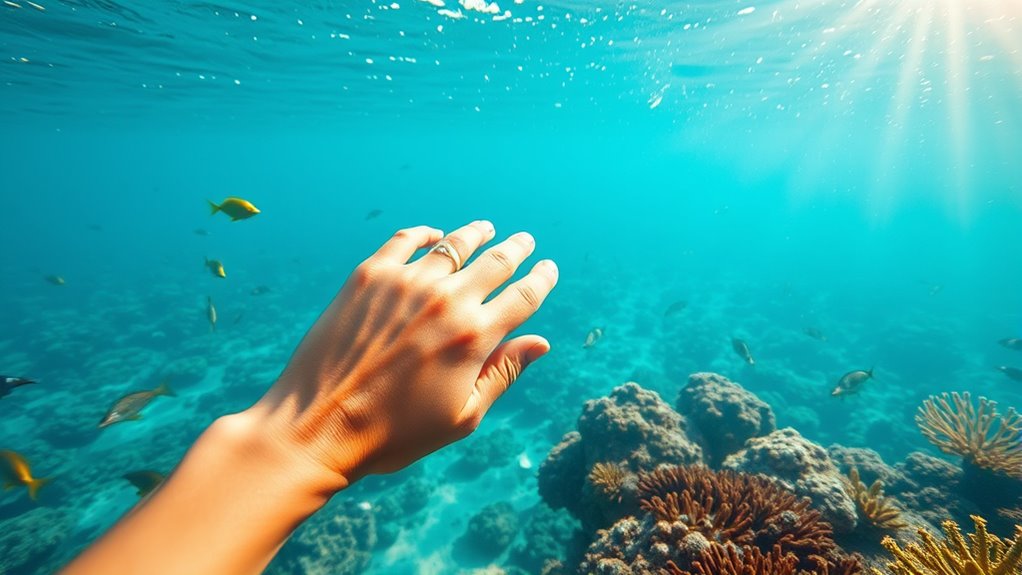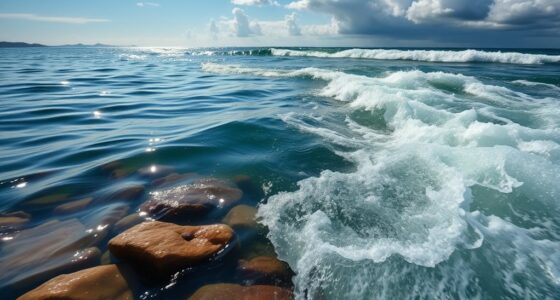To choose eco-friendly sunscreen that protects coral reefs, opt for mineral-based formulas with zinc oxide or titanium dioxide, avoiding harmful ingredients like oxybenzone, octinoxate, and parabens. Select products labeled reef-safe, water-resistant, and environmentally friendly. Make certain you apply generously and reapply often, especially after swimming. By choosing brands committed to sustainability, you help preserve marine ecosystems. Keep exploring to discover top brands and tips for effective, eco-conscious sun protection.
Key Takeaways
- Select mineral-based sunscreens containing zinc oxide or titanium dioxide, which reflect UV rays without harming reefs.
- Check ingredient labels to avoid oxybenzone, octinoxate, homosalate, octocrylene, and parabens.
- Choose reef-safe brands that use biodegradable packaging and prioritize sustainable sourcing.
- Reapply sunscreen every two hours and after swimming to reduce chemical runoff into water ecosystems.
- Incorporate protective clothing and seek shade during peak sunlight to minimize reliance on chemical sunscreens.
Understanding the Impact of Sunscreens on Marine Ecosystems

Although sunscreens protect your skin from harmful UV rays, many contain chemicals that can harm marine ecosystems. When you swim or wash off sunscreen in the water, these chemicals enter the ocean and can cause serious damage. Certain ingredients, like oxybenzone and octinoxate, have been linked to coral bleaching, which weakens and kills coral reefs. These chemicals also affect marine life, disrupting reproductive systems of fish and shellfish. Over time, this damage can lead to a decline in biodiversity and threaten entire ecosystems. By understanding how your sunscreen impacts the environment, you can make smarter choices. Opting for reef-safe options reduces the risk of pollution and helps preserve delicate marine habitats for future generations. Additionally, being aware of credit card security measures can help you avoid financial fraud when purchasing eco-friendly products online.
Key Ingredients to Avoid in Reef-Safe Sunscreens
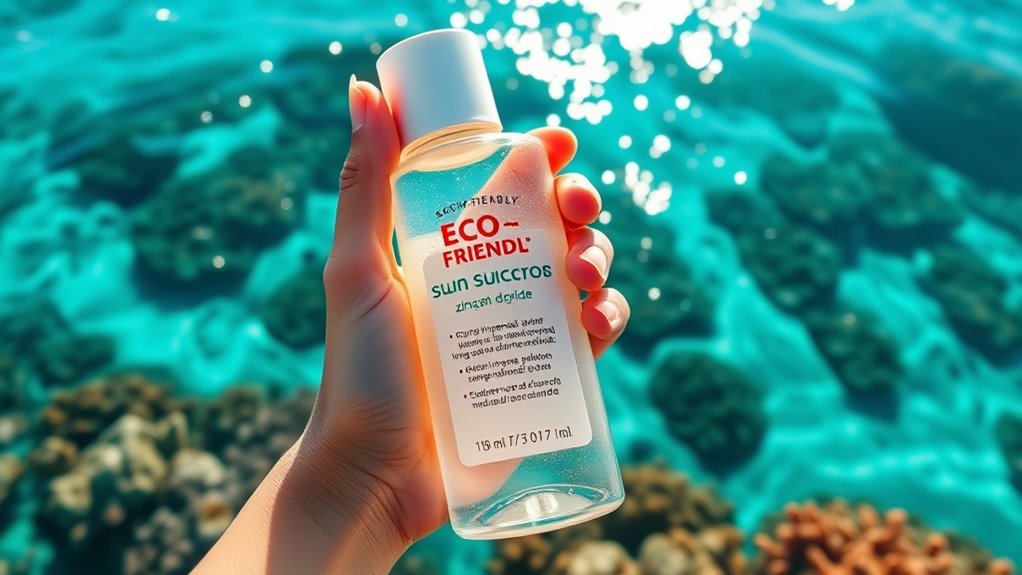
To make certain your sunscreen is truly reef-safe, it’s crucial to avoid certain harmful ingredients. Many traditional sunscreens contain oxybenzone and octinoxate, chemicals linked to coral bleaching and DNA damage in marine life. These ingredients often wash off easily, entering the water and harming ecosystems. Additionally, avoid ingredients like homosalate, octocrylene, and parabens, which can be toxic to coral and marine organisms. Mineral-based sunscreens with zinc oxide or titanium dioxide are safer options, as they sit on the skin’s surface and reflect UV rays without penetrating the water. Always check labels carefully to ensure these harmful chemicals aren’t present. Choosing products free of these ingredients helps protect delicate coral reefs while keeping your skin safe from UV damage. Incorporating appropriate UV protection technology such as mineral filters can also enhance reef safety. Being aware of environmentally friendly formulations can further support the preservation of marine ecosystems.
Features of Effective Eco-Friendly Sun Protection Products
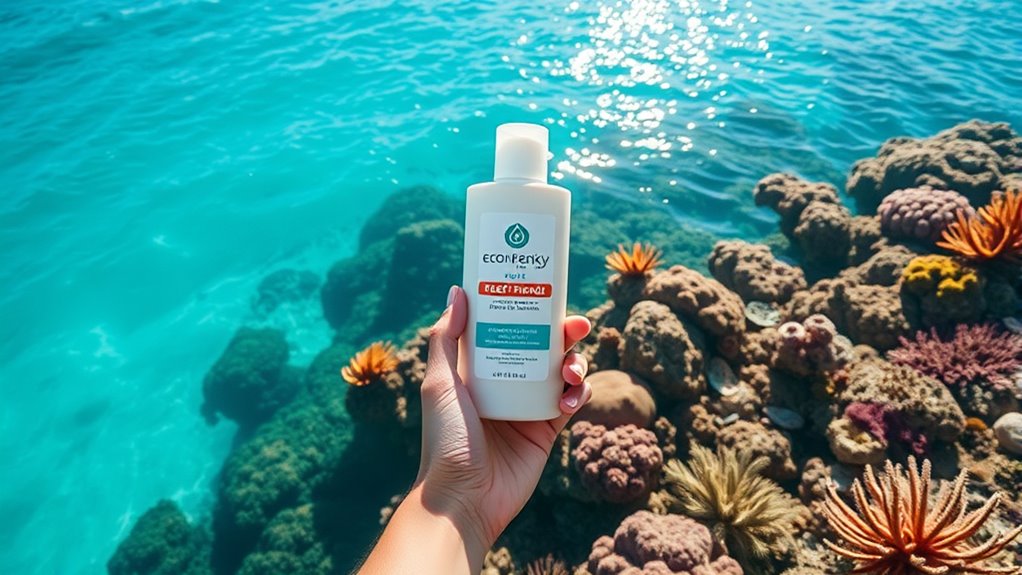
Effective eco-friendly sun protection products combine safety for your skin with minimal environmental impact. Look for formulas that use mineral-based ingredients like zinc oxide or titanium dioxide, which sit on your skin and reflect UV rays without harming coral reefs. These products should be free from oxybenzone, octocrylene, and other chemicals known to damage marine life. A good eco-friendly sunscreen is also water-resistant, so it stays effective during swimming or sweating, reducing the need for reapplication. Choose products in biodegradable packaging to lessen plastic waste. Additionally, opt for brands that prioritize sustainable sourcing and transparent ingredient lists. By focusing on these features, you ensure your sun protection is both effective and environmentally responsible, helping to preserve our oceans’ delicate ecosystems. Understanding reef-safe ingredients can further guide you in selecting truly eco-conscious products. Incorporating eco-friendly certifications can also provide assurance of a product’s environmental integrity.
Tips for Choosing and Applying Reef-Safe Sunscreens

Choosing the right reef-safe sunscreen involves more than just picking a product labeled as eco-friendly. First, check the ingredients—avoid oxybenzone and octinoxate, which harm corals. Instead, look for mineral-based formulas with zinc oxide or titanium dioxide, as they’re gentler on reefs. Apply sunscreen generously, covering all exposed skin at least 15 minutes before going outside. Don’t forget often-missed spots like ears, back of neck, and tops of feet. Reapply every two hours, or immediately after swimming or sweating. Use a broad-spectrum formula to protect against UVA and UVB rays. For ideal coverage, consider wearing protective clothing and seeking shade during peak sunlight hours. Proper application and thoughtful product choice make your sun protection safer for reefs and more effective for you. Additionally, choosing vetted reef-safe sunscreens can ensure you’re using products tested for environmental safety and effectiveness.
Brands Leading the Way in Sustainable Sun Care
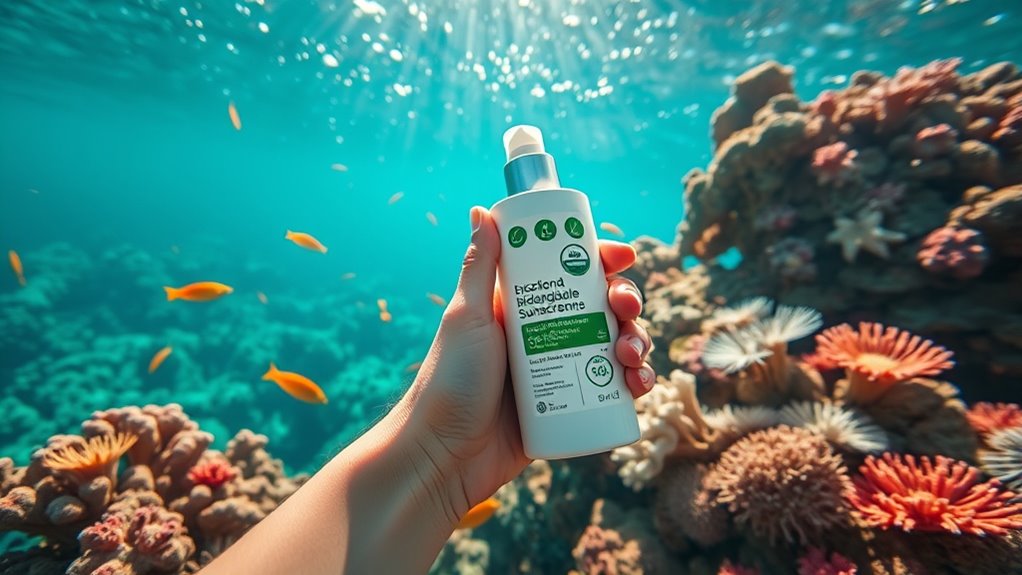
Have you wondered which brands are setting the standard for sustainable sun care? Several companies lead the way by prioritizing reef-safe ingredients, eco-friendly packaging, and transparent sourcing. These brands focus on minimizing environmental impact while providing effective protection. For example, think about brands like:
| Brand | Key Features | Eco Commitment |
|---|---|---|
| Badger | Mineral sunscreens, biodegradable packaging | Carbon-neutral certified |
| Reef Safe | Reef-safe ingredients, recyclable packaging | Supports coral conservation |
| All Good | Plant-based, reef-friendly formulas | Uses renewable energy |
| Solara | Reef-safe, biodegradable containers | Partners with ocean charities |
| Banana Boat | Eco-friendly lines, responsible sourcing | Reduces plastic waste |
These brands prove that protecting your skin and the planet can go hand in hand, especially when they incorporate sustainable ingredients and environmentally conscious practices.
Frequently Asked Questions
How Long Does Reef-Safe Sunscreen Typically Last on the Skin?
You’re wondering how long reef-safe sunscreen lasts on your skin. Typically, it stays effective for about two hours, but factors like swimming, sweating, and towel drying can reduce its protection. To keep your skin safe, reapply every two hours, especially after water exposure or sweating. Using a broad-spectrum, water-resistant formula can help maintain protection longer, but regular reapplication is key to ensuring continuous coverage.
Are Mineral-Based Sunscreens Better for Sensitive Skin Types?
Did you know that mineral-based sunscreens often contain zinc oxide or titanium dioxide? If you have sensitive skin, these ingredients are typically gentler, reducing irritation and allergic reactions. You’ll likely find mineral sunscreens better suited for your skin because they form a physical barrier, reflecting UV rays without penetrating deeply. This makes them a safer, more effective choice for sensitive skin types, especially if you want to avoid harsh chemicals.
Can Eco-Friendly Sunscreens Be as Effective as Traditional Products?
You might wonder if eco-friendly sunscreens work as well as traditional ones. The good news is, many eco-friendly options use mineral filters like zinc oxide or titanium dioxide, which provide broad-spectrum protection just like chemical sunscreens. When applied properly, these sunscreens can be just as effective at blocking harmful UV rays. Plus, they’re safer for your skin and better for protecting our environment and coral reefs.
How Should I Store Reef-Safe Sunscreen for Maximum Longevity?
You might think storing reef-safe sunscreen is straightforward, but proper storage really guarantees its effectiveness. Keep it in a cool, shaded place away from direct sunlight and heat, as high temperatures can break down the active ingredients. Make sure the cap is tightly sealed to prevent evaporation or contamination. By following these tips, you ensure your sunscreen remains effective longer, providing reliable protection while helping to preserve coral reefs.
Are There Any Certifications That Guarantee Reef-Safe Sunscreen Claims?
You wonder if certifications guarantee reef-safe sunscreen claims. Look for trusted labels like the Environmental Working Group (EWG) Verified, Mineral Sunscreen Certification, or Marine Stewardship Council (MSC) approval. These certifications verify products meet strict standards for safety and environmental impact. While no single certification is foolproof, choosing sunscreens with recognized labels helps you make informed, eco-friendly choices that protect reefs and your skin.
Conclusion
By choosing reef-safe sunscreens, you’re planting seeds of change beneath the waves, nurturing vibrant coral gardens instead of tearing them down. Every swipe becomes a ripple of hope, protecting the delicate balance of marine life. Remember, your sunscreen is more than protection for your skin—it’s a shield for the ocean’s future. Make mindful choices today, and watch how your small actions can turn into a tidal wave of positive change for our reefs.

